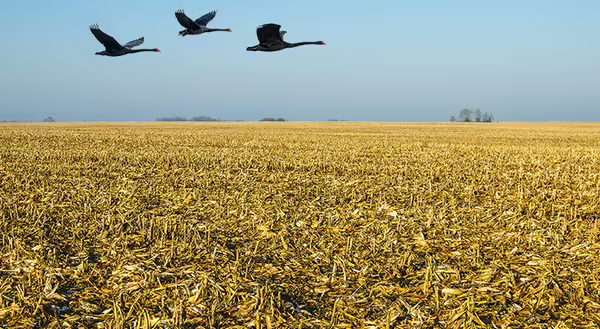
I recently read an article in an ag publication entitled, “Are the Black Swans Flying?” Each day, there seems to be another article or podcast that talks about the current low commodity price – high input cost economic squeeze of grain farmers. The Federal Reserve Banks of Chicago, Kansas City, and Minneapolis have reported deteriorating farm credit conditions across their member banks for grain farmers.
Is the current economic downturn for U.S. grain farmers a “black swan” event? We do not know at this time, but current economic projections are saying that these low prices will probably linger for 2 to 3 years before new market demand develops for U.S. grains.
A recent study by the University of Illinois farmdoc team found that 75% of Illinois grain farms have strong debt-to-asset ratios, which is good. However, the other 25%, with the highest debt servicing costs, signals an increase in financial strain. With U.S. farm sector debt projected to reach $591.8 billion in 2025 and farm bankruptcies rising, farmers should prioritize diligent recordkeeping and monitor debt ratios to ensure sufficient margins for debt payments, especially as elevated borrowing costs heighten risks for highly indebted operations.”
What are the strategies for surviving during low-profit years?
- Talk with your ag lender. Keep them abreast of your current financial situation regarding loan repayments.
- You need to have an advisory team of experts and trusted peers who can provide you with sound advice.
- Hold off on major equipment purchases except where replacement is necessary to maintain profitability.
- Evaluate your tillage program and determine if all the tillage passes are necessary. Switching from using a combination ripper (disc-ripper) to disc tillage will save you an estimated $15 per acre. One pre-plant tillage pass instead of two will save another $15 per acre.
- Are your nitrogen fertilizer rates in line with the Corn Nitrogen Rate Calculator? These are research-based recommendations that are evaluated every year when new data is added. Applying rates higher than the recommended range is probably is giving you higher yields but lower profits.
- Are your soil tests current? The latest recommendations from the I-state universities are to sample at least once every 3 to 4 years. Low soil pH limits the availability of soil nutrients; below 5.8, soil pH limits your crop’s potential. “Lime is the cheapest fertilizer that you can apply.”
- Review your soil tests. If soil test P & K levels are above the recommended values, then reduce those fertilizer inputs above the recommended levels, and be sure to consult with your soil fertility adviser when making final soil fertility decisions.
- Evaluate all your cropping practices based on whether it is making you money or costing you money. Right now, it's profit per acre, not bushels per acre, that leads to financial success.
- Are there any additional sources of income to supplement your farm income?
- Above all else, practice good self-care of your mental and physical health.
If you or someone you know is suffering from farm-related stress, the University of Illinois ‘Farm Stress’ website has information about stress-relieving exercises, where to get help NOW, and information on the Illinois agricultural mental health voucher program for farmers and their families.